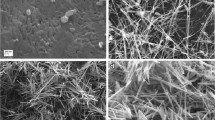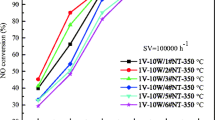Abstract
Vanadium oxide nanotubes (VOx-NTs) have been synthesized by using n-butylamine as structure-directing template and V2O5 as precursor under hydrothermal conditions. XRD, FTIR, SEM, TEM, BET and TG-DTA characterizations have been performed to both optimize the synthetic conditions and understand the growth mechanism of VOx-NTs. The results showed that open-ended VOx-NTs were obtained under the optimized conditions (hydrothermal temperature: 150–160°C, hydrothermal time: 5–7 d, the molar ratio of V2O5 to n-butylamine is 1:1) with diameters ranging from about 30 to 100 nm and several micrometers in length. The BET surface area and the desorption cumulative pore volume of pores of the as-synthesized sample were about 27.4609 m2/g and 0.191087 cm3/g, respectively. The result presents that the synthesis of VOx-NTs is controlled by the “rolling” mechanism and temperature is primary driving force for rolling.
Similar content being viewed by others
References
Ma Y T, Lin Y A, Xiao X R, et al. Synthesis of TiO2 nanotubes film and its light scattering property. Chin Sci Bull, 2005, 50(18): 1985–1990
Shen X P, Liu H J, Fan X, et al. Construction and photoluminescence of In2O3 nanotube array by CVD-template method. J Cryst Growth, 2005, 276: 471–477
Chen Y H, Zhang X T, Xue Z H, et al. Fabrication and structural characterization of large-scale uniform SnO2 nanotube arrays by sol-gel method, Chin Sci Bull, 2005, 50(7): 618–621
Kong X H, Sun X M, Li X L, et al. Catalytic growth of ZnO nanotubes. J Mater Chem Phys, 2003, 82: 997–1001
Chandrappa G T, Steunou N, Cassaignon S, et al. Hydrothermal synthesis of vanadium oxide nanotubes from V2O5 gels. Catalysis Today, 2003, 78: 85–89
Yu J G, Liu S W, Cheng B, et al. Polymer-directed large-scale synthesis of single-crystal vanadium. Mater Chem Phys, 2006, 95: 206–210
Chen S H, Ma H, Wang S B, et al. Vanadium oxide thin films deposited on silicon dioxide buffer layers by magnetron sputtering. Thin Solid Films, 2006, 497: 267–269
Yu L, Zhang X G. Hydrothermal synthesis and characterization of vanadium oxide/titanate composite nanorods. Mater Chem Phys, 2004, 87: 168–172
Mai L Q, Chen W, Xu Q, et al. Cost-saving synthesis of vanadium oxide nanotubes. J Solid State Commun, 2003, 126: 541–543
Chen W, Mai L Q, Xu Q, et al. Synthesis, structure and electrochemical performance of vanadium oxide nanotubes. Chem J Chin Univ, 2004, 25: 904–907
Kumeich F, Muhr H J, Niederberger M, et al. Morphology and topochemical reactions of novel vanadium oxide nanotubes. J Am Chem Soc, 1999, 121: 8324–8331
Chen X, Sun X M, Li Y D. Self-assembling vanadium oxide nanotubes by organic molecular templates. Inorg Chem, 2002, 41: 4524–4530
Krumeich F, Muhr H J, Niederberger M, et al. Morphology and topochemical reactions of novel vanadium oxide nanotubes. J Am Chem Soc, 1999, 121: 8324–8331
Niederberger M, Muhr H J, Krumeich F, et al. Low-cost synthesis of vanadium oxide nanotubes via two novel non-alkoxide routes. Chem Mater, 2000, 12: 1995–2000
Bouhedja L, Steunou N, Maquet J, et al. Synthesis of polyoxovanadates from aqueous solutions. J Solid State Chem, 2001, 162: 315–321
Pavasupreea S, Suzukia Y, Kitiyanana A, et al. Synthesis and characterization of vanadium oxides nanorods. J Solid State Chem, 2005, 178: 2152–2158
Valmalette J C, Gavarri J R. High efficiency thermochromic VO2(R) resulting from the irreversible transformation of VO2 (B). Mater Sci Eng B, 1998, 54: 168–173
Chen W, Peng J F, Mai L Q, et al. Synthesis of vanadium oxide nanotubes from V2O5 sols. J Mater Lett, 2004, 58: 2275–2278
Janauer G G, Bobly A, Guo J D, et al. Novel tungsten, molybdenum, and vanadium oxides containing surfactant ions. Chem Mater, 1996, 8: 2096–2101
Author information
Authors and Affiliations
Corresponding author
Additional information
Supported by the Research Fund for the Doctoral Program of Higher Education (Grant No. 20050010014)
About this article
Cite this article
Wei, J., Zhu, Y. & Zhang, J. Effects of synthetic conditions on the structure and morphology of open-ended vanadium oxide nanotubes and study of their growth mechanism. Chin. Sci. Bull. 52, 1920–1924 (2007). https://doi.org/10.1007/s11434-007-0287-9
Received:
Accepted:
Issue Date:
DOI: https://doi.org/10.1007/s11434-007-0287-9




